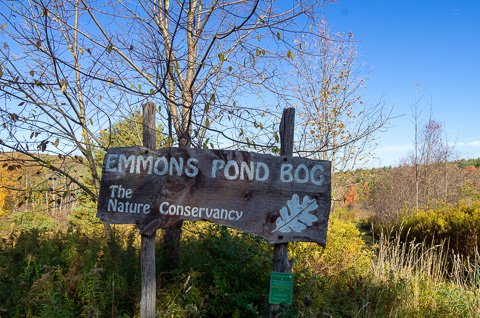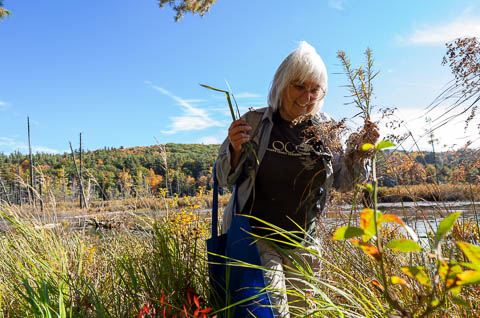
Welcome to the Bog!
Welcome to Emmons Pond Bog Preserve. The history of the pond and bog dates back 11,000 years, when the retreat of the last glacier left a depression that soon filled with water. The pond and bog provides a home for many species of birds, frogs, a variety of wildflowers and ferns, woodland animals like deer and porcupines, and of course the key engineer of this ecosystem, the beaver. The beavers cut down trees with their sharp teeth and build dams that raise the water level, enlarging the wetland. The beaver colony at Emmons Pond Bog has been active for many years, and the beavers' preferred food, poplar trees, have all been downed. The beavers may soon abandon this area and colonize another.
The Ecosystems of the Preserve
The Emmons Pond Bog Preserve, although relatively small, contains three distinct ecosystems: the meadow, the forest, and the bog itself. As you walk the interpretive trail, this guide will introduce you to all three and highlight some of these ecosystems unique features and species. Though distinct, the meadow, forest and bog are of course interconnected. You'll see areas where the forest is taking over from the meadows, and where the rising waters of the bog have claimed some of the forest. Nature is in a constant state of change, even if human attention spans are often too short to see it.
Drivers of Ecological Change
Many forces interact and collude to drive change in the natural world. The bog itself is a result of global climate change driven by long cycles of heating and cooling of the planet that create what we call ice ages, and the mild periods between (like the one we're living in now). On smaller time scales, the forest landscape is shaped dramatically by fire, wind, and water.
People also drive change in the natural world. Decades ago, farmers cut down many of the trees and cleared rocks from the land around Emmons Pond, piling them up into walls that served as property markers. You may see some of these walls in the woods off the main trail. A few trees were left to serve as additional property markers and provide shade for the livestock that grazed these man-made meadows.
Before you enter the trail, look around you. Though this region is now heavily forested, historic photographs reveal that almost all the land in this area was once clear-cut and used for farming. The forest you see now is relatively recent, a testament to the resilience of the natural world.
The Trail
The 1.4 mile loop trail runs counterclockwise around the bog; take the right fork just after the parking area and head downhill. You'll cross a meadow, a seasonal brook, and enter the woods, where you will get your first view of the pond. Here you will find the sign-in box and a spur trail to the left which will take you to the shore of the bog. There used to be a boardwalk over the peat bog itself, but rising water levels submerged it years ago.

A note from Donna Vogler, biology professor at SUNY Oneonta and steward of the Emmons Pond Bog Preserve:
“The bog, like a lot of bogs in our area, are remnants of glaciation. The glaciers that covered this area were in some cases a mile thick, and sometimes large balls of ice were caught under them and crushed down into the earth by the enormous weight. When the glaciers retreated, 10 or 15 thousand years ago, those deep bowls became kettle hole bogs and that’s what Emmons bog is. There are other types of bogs, but they all have one thing in common: a quaking surface, usually nestled between sphagnum peat moss and some low, shallow-rooted shrub, such as leatherleaf, which is what we have here. In between that, there are things like pitcher plants and other carnivorous plants."
"Spin forward now 5 or 6 thousand years and you have the present day. This was an agricultural field, and in fact, there are a couple of old stock ponds here that were used to water cattle. I don’t think the cattle ever used the bog itself because it probably would have been treacherous for the animals to walk on, so they probably had that fenced off. Now the Nature Conservancy maintains this area as a preserve. Its main function is to preserve the integrity of the bog, and recreation is secondary. Visitors are encouraged to enjoy this unique environment, but are asked to respect this area of natural beauty.”